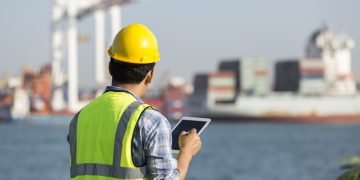Blockchain, cloud-based technology and virtual reality are becoming familiar terms across the shipping industry as they offer huge potential to transform how shipping organisations will operate in the future. However, do shipping organizations have digitalization initiatives currently underway?
This article presents five technologies that have entered the shipping industry lately and they are about to reshape it in the years to come!
- Blockchain technology
Within the maritime industry blockchain has already made the transaction process decentralized and eventually easy to track. Decentralizing the process of banking removes middlemen, thus reducing the cost of transactions allowing parties to save both time and money. There is no need of inputting paper booking information and Bill of Lading. Transaction parties can now be directly connected and proceed in real-time exchanges of supply chain documents and transactions, while Certificate of Origin and customs clearance information can be shared securely. Maersk and IBM have already launched blockchain-based trade platforms, while other organizations are following.
- Autonomous ships
Automation has the potential to increase safety through a separate way. Supporters of autonomous ships mostly focus on the signs that this trend shows to reduce the risk of human error on board, which has been the main cause of accidents at sea. Indeed, supposing that no personnel will be onboard no more human errors would occur, no one would get injured. Studies indicate that sailor-less ships would be managed from land-based facilities focusing mostly on specific tasks rather than entire jobs. To this effect, new positions will replace those being automated; augmenting rather than replacing humans. Of course, it’s hard to predict how autonomous shipping will unfold. Luckily, the development of such ships is not about to happen at once. As of now many North European countries proved particularly supportive to the development of autonomous maritime operations.
Norway opened this year two more test bed areas for testing of autonomous vessels, in Horten and in Storfjord, after the first at the Trondheim fjord, in late 2016. Finland also inaugurated in late summer the opening of theJaakonmeri autonomous maritime test area, the first to be globally open for such purpose. To address liability issues involving unmanned vessels, Denmark called in December for an international regulation on autonomous ships.
In addition, UK Ship Register signed its first unmanned vessel, while it also launched an Industry Code of Practice for the design, construction and operation of autonomous maritime systems.British giant Rolls-Royce took the lead this year in vessel automation agreements, including the cooperation with Google, to boost its artificial intelligence based object classification system for detecting the objects a vessel can encounter at sea. The company also demonstrated the world’s first remotely operated commercial vessel in Copenhagen harbor, in cooperation with Svitzer.
In the meantime, Japanese Yara and Norwegian Kongsberg joined forces in June to launch ‘Yara Birkeland’, the world’s first zero-emissions, fully electric and autonomous container ship to start fully unmanned operation by 2020.
- Cloud-based technology
Cloud technology not only helps accessing data easily regardless of time or location, as well as reduce data silos. According to a study by the International Data Group, 69% of businesses are already using cloud technology and 18% say they plan to implement cloud-computing solutions at some point. In particular, this ground-breaking technology is an asset for shipping industry as well as it offers:
- Better communication between staff at land and sea
- Cost savings
- Remote access to corporate data
- Data loss prevention
- Virtual Reality (VR)
The strongest demand for AR and VR technology comes from creative industries. The impact of virtual reality is increasing exponentially in maritime, mainly in the field of engineering, training, and inspection because it can offer major improvement.
Cost-effective software and hardware solutions for Virtual Reality have already helped maritime industry to adapt its options and bring them to beneficial use. Specifically, in May 2017, Winterthur Gas & Diesel installed its W-Xpert Full Mission Simulator for training complete engine room crews, at the Marine Power Academy Training Centre of HHM, in Shanghai, China while DNV GL held its traditional press conference at the Nor-Shipping trade fair showcasing the company’s innovative vision, with attendees taking part in a virtual reality (VR) presentation.
- Voice-controlled devices
2017 was a milestone year for voice-first computing, which is a category that goes beyond the in-home smart speakers. As long as the technology advances voice-controlled devices will also have an impact in shipping organisations by accessing information in quicker and easier way using voice commands!
Voice implementation has already made its appearance in aviation and truck fleet inspection, where clipboard inspections processes have been turned into full voice guided inspection processes. New focus areas for voice implementation are the automotive, vessel and cargo inspection, with the scope to convert into voice all defined inspection process steps, allowing real time inspection and hands-free documentation.
At the 2018 SMART4SEA Conference, Apostolos Belokas, Managing Editor, SAFETY4SEA, presented an overview of the developments over the last 12 months in the areas of Big Data, Connectivity Onboard, 3D printing, Drones, Blockchain tech, Cryptocurrency, Virtual Reality, Cyber Security and Autonomous Shipping.



































































